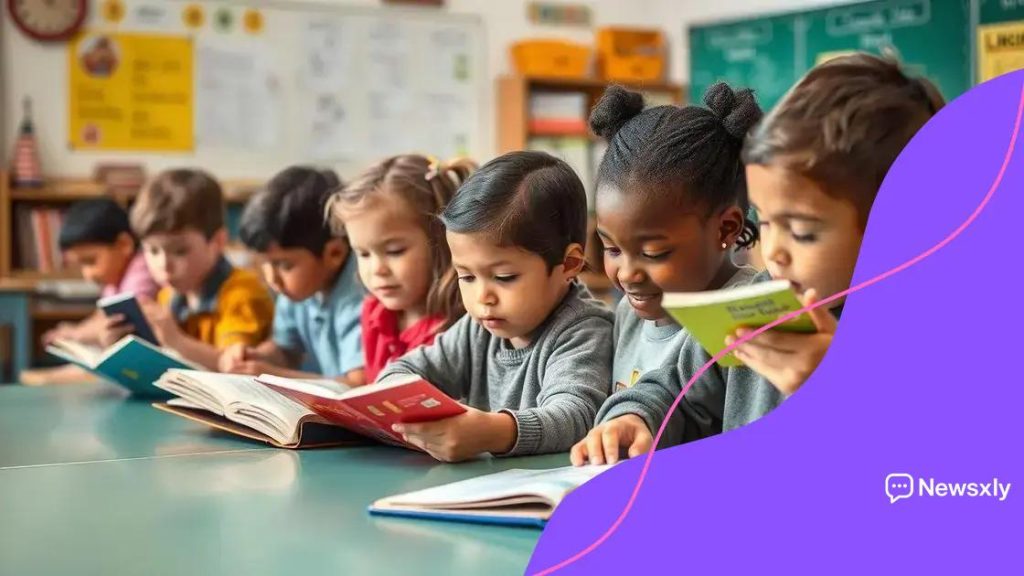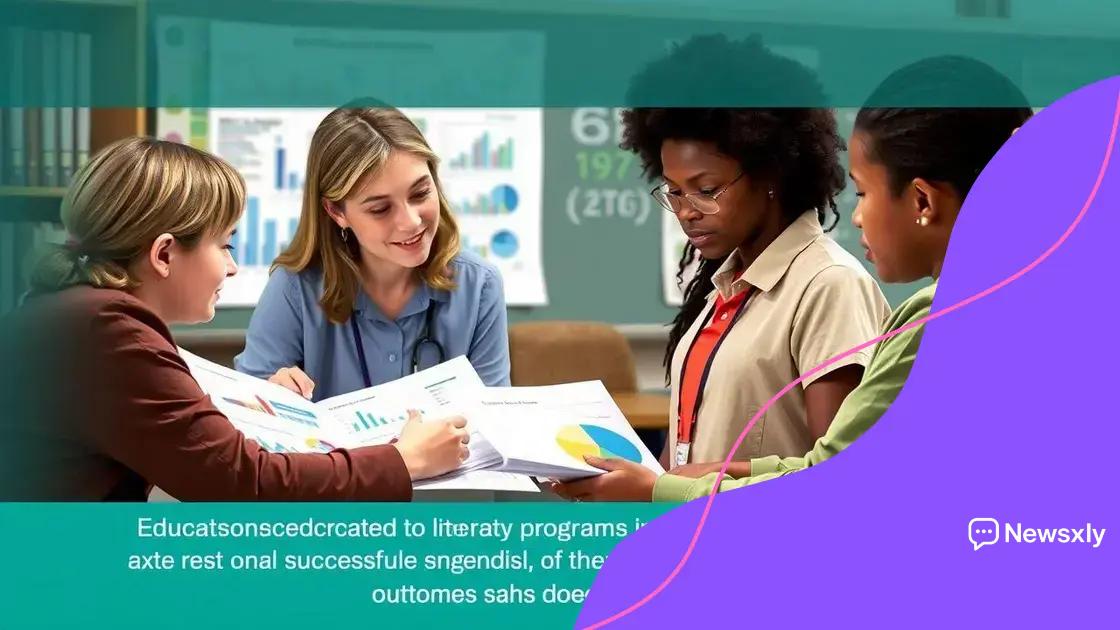Investment strategies for early literacy programs

Investment strategies for early literacy programs focus on community collaboration, effective funding solutions, and measuring outcomes to foster reading skills and improve educational success for young learners.
Investment strategies for early literacy programs play a crucial role in shaping future generations. Ever wondered how targeted funding can radically enhance reading skills in young children? Let’s dive into effective strategies.
Understanding the importance of early literacy
Understanding the importance of early literacy is crucial for building a strong educational foundation. Early literacy skills not only help children learn to read but also foster their overall cognitive development. When young learners engage with words and stories, they develop a love for reading that can last a lifetime.
Why Early Literacy Matters
Early literacy impacts future academic success. Children who read proficiently by the end of third grade are more likely to succeed in school and beyond. Moreover, these skills influence critical thinking, communication, and social skills, preparing children for a lifetime of learning.
Key Benefits of Early Literacy Development
- Enhances vocabulary acquisition
- Improves comprehension and retention
- Encourages critical thinking skills
- Boosts confidence in communication
Furthermore, early literacy is not just about the ability to read and write. It encompasses a rich tapestry of skills and knowledge that children absorb from their environment. Engaging with books, songs, and storytelling from a young age creates numerous pathways for learning.
Parents and caregivers can play a fundamental role in nurturing these skills. Simple activities, such as reading aloud daily or providing access to diverse reading materials, can make a significant difference. Encouraging discussions about stories further enriches a child’s understanding and enjoyment of reading.
The Role of Play in Early Literacy
Moreover, playful learning experiences, such as playing with letters or rhymes, enhance literacy skills before formal education begins. These playful activities stimulate curiosity and creativity, essential components of nurturing a love for literature.
In summary, recognizing the importance of early literacy lays the groundwork for academic achievement and lifelong learning. By giving children the tools they need in their early years, we are investing in their future success and the ability to navigate the world with confidence.
Strategies for funding literacy programs
Strategies for funding literacy programs are essential for ensuring that children have access to the learning resources they need. Identifying sources of funding can significantly impact the success of these initiatives and foster a culture of reading in communities.
Government Grants and Allocations
One of the primary ways to secure funding is through government grants. Various federal, state, and local programs offer financial support specifically aimed at literacy enhancement. Understanding how to navigate these grants is key for program managers.
- Research available grants in your area.
- Prepare comprehensive proposals that highlight the program’s objectives.
- Show evidence of past successes and community support.
Additionally, it can be beneficial to form partnerships with local government officials, who may have insights into specific funding opportunities available for educational programs.
Private and Corporate Sponsorships
Private donations and corporate sponsorships can also provide significant funding for literacy programs. Many businesses see the value in promoting education and are willing to invest. Building relationships with local industries can yield fruitful results.
- Develop a clear case for support outlining community benefits.
- Host events that engage potential sponsors and showcase the program.
- Communicate effectively and build ongoing relationships to maintain support.
Moreover, leveraging social media and community outreach can raise awareness about your literacy program, inspiring individuals and businesses to contribute.
Fundraising Initiatives
Grassroot fundraising efforts are another way to support literacy programs. Engaging the community through fundraising events brings in direct support and fosters a sense of ownership and pride among participants. Activities like book fairs, read-a-thons, or literacy nights can be both fun and effective.
Utilizing various channels, including crowdfunding platforms, can also amplify your reach. These tools allow individuals to contribute to the cause easily and share with their networks, increasing overall funding.
In summary, diversifying funding sources through government grants, private donations, corporate partnerships, and community fundraising initiatives is vital for sustaining literacy programs. Each strategy contributes to building a robust foundation for successful literacy development and enhances opportunities for children.
Measuring the impact of investments

Measuring the impact of investments in literacy programs is essential for understanding their effectiveness. Evaluating these programs helps stakeholders see the tangible benefits of their funding and can guide future investment decisions.
Collecting Data
The first step in measuring impact is collecting the right data. This can include standardized test scores, attendance records, and student engagement levels. By using a mix of qualitative and quantitative measures, programs can gain a comprehensive view of their success.
- Track student reading levels before and after program participation.
- Survey parents and teachers for feedback on student progress.
- Analyze participation rates to gauge community involvement.
In addition, documenting stories and testimonials from students and families can highlight personal successes and show the human side of the data, making it more relatable for potential funders or stakeholders.
Setting Clear Benchmarks
Establishing benchmarks is vital for measuring success. Setting clear goals allows programs to define what success looks like and to review progress regularly. These benchmarks can include specific literacy skills, such as phonemic awareness or reading comprehension levels.
- Define short-term and long-term objectives.
- Regularly assess progress toward these goals.
- Adjust programs as necessary based on feedback and results.
Furthermore, communicating these benchmarks to all stakeholders ensures alignment and encourages accountability. When everyone is aware of the goals, it fosters a sense of community and shared purpose.
Evaluating Outcomes
Evaluating the outcomes of literacy investments involves looking not just at immediate results, but also at long-term benefits for students. This may include improved academic performance across subjects and increased school retention rates.
Longitudinal studies can provide insight into how literacy skills impact students over time, which can be crucial for justifying continued funding. Schools that track students over multiple years can gather valuable insights into the lasting effects of early literacy.
Ultimately, measuring the impact of investments requires a comprehensive approach that combines data collection with community feedback. By being proactive about evaluating success, literacy programs can refine their efforts and demonstrate their value to stakeholders.
Partnerships in early education funding
Partnerships in early education funding are vital for creating a robust support system for literacy programs. Collaborations among schools, nonprofit organizations, government agencies, and businesses can lead to more effective and sustainable funding solutions.
Benefits of Partnerships
When different entities come together, they can pool resources and expertise. This collaboration helps broaden the scope of what a literacy program can achieve. Community involvement fosters a sense of ownership and allows for a more inclusive approach.
- Shared funding reduces the financial burden on any single entity.
- Access to diverse resources enhances program delivery.
- Collaborative efforts can lead to innovative solutions to challenges faced.
Furthermore, partnerships can enhance visibility. When organizations team up, they often gain a larger audience, which can attract additional support and resources by showcasing the collective impact on literacy.
Finding the Right Partners
Identifying potential partners who share a common goal is key. Schools may look to local businesses for sponsorship, while nonprofits can provide valuable educational resources and expertise. It’s essential to establish relationships with those who have a stake in the community’s success.
- Conduct outreach to local organizations aligned with educational goals.
- Engage with businesses interested in community development.
- Build connections with other educational institutions for resource sharing.
Moreover, having a clear vision of what partnership means for each party helps set expectations and responsibilities. Open communication ensures that all partners are aligned and committed to the program’s success.
Examples of Successful Collaborations
Many successful literacy initiatives have emerged from strong partnerships. For example, collaborations between schools and libraries often create essential reading programs that promote access to books and literacy resources. Local businesses may sponsor reading initiatives or events, effectively enhancing community engagement.
Additionally, partnerships with governmental agencies can secure grants specifically targeting early literacy. Such funding is often essential for launching new programs or expanding existing ones.
In summary, partnerships in early education funding are crucial for supporting literacy programs. By collaborating and leveraging shared goals, stakeholders can create more impactful and sustainable initiatives.
Examples of successful literacy initiatives
Examples of successful literacy initiatives showcase how effective programs can transform reading skills in children. These initiatives often highlight the importance of community involvement, partnerships, and innovative approaches to teaching.
Reading Recovery Program
The Reading Recovery program targets first graders who struggle with reading. It provides intensive, one-on-one support to help these students achieve grade-level literacy. Trained teachers work with children in short sessions to boost their reading and writing skills. This focus on individualized instruction has shown impressive results, with many students reading at or above their grade level after just 12 to 20 weeks of instruction.
Libraries and Schools Collaboration
Many libraries partner with local schools to enhance literacy. Through programs like summer reading challenges, they engage students in reading outside the classroom. These initiatives encourage children to read for pleasure and show the connection between education and community resources.
- Summer reading camps invite students to explore new books.
- Libraries often provide workshops for parents on supporting their children’s literacy.
- Mobile libraries bring books to underserved areas, improving access to reading materials.
This collaboration not only fosters a love for reading but also strengthens community ties.
Literacy Mentorship Programs
Another successful initiative involves pairing children with literacy mentors. These programs connect volunteers with students to provide guidance and encouragement in reading. Mentors engage children in fun and relatable ways, which significantly boosts their enthusiasm for learning.
Through these interactions, students often show improved self-esteem and motivation, paving the way for greater academic success. Mentorship initiatives not only improve literacy skills but also foster lasting relationships that benefit the child both academically and socially.
Technology-Driven Literacy Programs
Incorporating technology into literacy initiatives has also proven effective. Various apps and online programs provide engaging ways for children to practice reading skills. These digital resources often include games and interactive content that resonate with today’s tech-savvy learners.
For example, platforms that allow students to read along with audio support have shown to improve fluency and comprehension. By merging technology with traditional reading practices, schools can empower students and make learning more accessible.
In summary, successful literacy initiatives come in various forms, from targeted programs like Reading Recovery to innovative partnerships and technology-driven solutions. Each example emphasizes the role of community and collaboration in fostering a love for reading and ensuring that all children have the opportunity to succeed.
FAQ – Frequently Asked Questions about Investment Strategies for Early Literacy Programs
What are the key components of effective early literacy programs?
Effective early literacy programs focus on individualized instruction, engaging materials, and community involvement. They often involve partnerships with schools, libraries, and families to enhance learning.
How can community collaboration enhance literacy initiatives?
Community collaboration brings together resources and expertise from various stakeholders. It fosters support and engagement, ensuring programs are well-funded and effectively meet the needs of learners.
Why is measuring the impact of literacy investments important?
Measuring the impact helps identify effective strategies and areas for improvement. It allows stakeholders to see the benefits of their investments and encourages continued support for literacy programs.
What role does technology play in modern literacy programs?
Technology enhances literacy programs by providing interactive and engaging resources. Digital tools can help personalize learning experiences and make reading more enjoyable for children.





